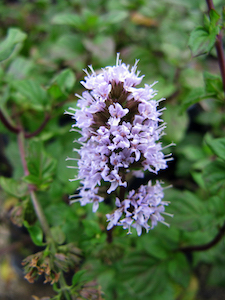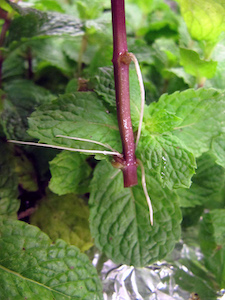Growing Mints - A 'Cool' Idea You Can Try At Home!

Published on
01 Jan 2022
Published by
National Parks Board
With the launch of the Gardening with Edibles campaign in June 2020, the interest to grow edibles has risen among Singaporeans. However, some corridors or windowsills may not provide enough sunlight to grow these greens optimally.
So while the passionate gardener seeks out alternatives like community and allotment gardening or set up grow lights to improve light conditions, these may be a little daunting for the new and casual gardener.
But here’s a ‘cool' idea even novice gardeners can try: how about growing mints?
Mints You Can Grow in Singapore
What kind of mints can you grow in Singapore? The most commonly available mints locally are the Spearmint (Mentha spicata) and Peppermint (Mentha × piperita).
Spearmint has light green leaves and contains very little menthol. The sweet minty flavour is ideal for cooking. Peppermint has darker green leaves that contain much more menthol than Spearmint. Peppermint has an icy cool taste which is good for herbal teas. These mints are vigorous growers which can flourish easily even for novice gardeners.
-vicky-lim-yen-ngoh.ashx?la=en) |
A close relative of Peppermint is a cultivar called Chocolate Mint (Mentha × piperita f. citrata ‘Chocolate’).
As its name suggests, crushed leaves release a chocolate-like aroma that can enhance the flavour of your favourite desserts and hot drinks. Its fragrance has been compared to a chocolate mint candy. |
|
|
Another interesting mint is the Eau de Cologne Mint (Mentha × piperita f. citrata ‘Eau de Cologne’). It is unusual in that it is grown for its fragrance rather than its flavour.
The crushed leaves of this mint give off a light, perfume-like fragrance. They can be dried and added to potpourri for a flowery and minty scent. |
-vicky-lim-yen-ngoh.ashx?h=300&w=225&la=en) |
While we usually think of mints as plants to grow for their edible leaves rather than their looks, Pineapple Mint (Mentha suaveolens ‘Variegata’) is both tasty and pretty!
The petite, light green leaves are beautifully edged in cream. Our climate can be too hot to grow the Pineapple Mint, so if you intend to do so, it is best to grow it in bright, filtered light under cooler temperatures. |
-vicky-lim-yen-ngoh.ashx?h=300&w=225&la=en&hash=22974B3C30AEA01D8DDDC24D96BFD0FC19380236) |
If Pineapple Mint gets too hot, it reverts to solid green and you end up with another type of mint—Apple Mint! This mint (Mentha suaveolens) has light green, softly hairy leaves. Both Pineapple and Apple Mint have a faint, fruity fragrance. |
-vicky-lim-yen-ngoh.ashx?la=en&hash=318C4ABD5ECAC1BAF90E72CA9A56B93009B8806E) |
Curly Mint (Mentha spicata var. crispa) is a good choice to add texture to your herb garden. Curly Mint is a variety of Spearmint that has undulating surfaces and ruffled edges. |
Stem-cutting To Propagate
Mints are adaptable plants which can grow both outdoors and indoors. They are easy to propagate via stem cutting, basically meaning you can ‘clone’ a new plant from the existing plant by using its stem.
Remove the lower leaves of a freshly cut stem and place it in freshwater until new roots form. You should see roots emerge within a week. Change the water regularly to prevent mosquito breeding. When the roots have developed sufficiently, transfer the stem and pot it in well-drained soil.
Simple Tips to Growing Mints
Once your mint plant is potted up, allow it to grow and establish. Here are five key tips for successfully caring for your mints:
1. Plant in well-drained soil
If your potting soil does not allow water to drain freely, you can mix in materials like LECA (Light Expanded Clay Aggregate, 4 mm in diameter), perlite, vermiculite, pumice rock or charcoal chips to improve drainage. Avoid planting your mint in pure compost because it tends to stay wet too long. Outdoor mints in well-drained soil may need to be watered at least once a day.
2. Provide bright, filtered light daily
Most mints will grow well when exposed to at least four to six hours of bright, filtered light (meaning, slightly shaded from the sun). However, Spearmint and Wild Mint (Mentha arvensis) are two mints that grow well in both full sun and bright, filtered light. If your garden receives afternoon sun, you may want to try growing these species.
In contrast, variegated mints (leaves with different colours) like the Pineapple Mint are best grown in bright, filtered light because the leaves may revert to a solid green if exposed to the intense heat from the sun.
3. Fertilise regularly
Like other edibles, mints are heavy feeders and should be fertilised once every two weeks with a balanced fertiliser that has equal parts of nitrogen, phosphorous and potassium. For organic sources of plant nutrition, you can apply compost, liquid seaweed (an excellent source of trace elements and plant growth hormones), bone meal (rich in phosphorous) and fish emulsion (high in nitrogen).
4. Protect from strong winds
If your garden tends to be windy, for example on balconies and corridor gardens, you can make an open, cone-shaped wind barrier by wrapping the pot with clear plastic sheeting, similar to the protective horticultural sleeves that plants are displayed in for sale. Many products are shrink-wrapped or enclosed in thin, transparent plastic sheets which can be recycled to make wind barriers too.
5. Harvest leaves regularly
Our final tip is arguably the most enjoyable part of growing mints – harvest your mint leaves regularly! Removing leaves stimulates the production of lush, bushy growth and prevents the plants from becoming leggy. Go on, enjoy your fresh and delicious mint tea with your harvest!
Mints come in an amazing variety of colours, textures, flavours and aroma profiles. Somewhere, there is a mint cultivar perfect for your best-loved recipes or potpourri mix just waiting to be discovered!
Gardening with Edibles
Watch this Gardening with Edibles Facebook Live Episode 2 clip to learn more about native plants as well as to gain tips on growing edibles.
The City in Nature vision seeks to bring greenery closer to all residents. The community plays a key role in the ownership and stewardship for nature which will benefit our health and well-being.
NParks is partnering residents to make Singapore our City in Nature and spark a love for community gardening through the Gardening with Edibles initiative launched in June 2020. Under this programme, some 400,000 free seed packets have been distributed to interested members of the public. Relevant resources are also available online, to guide gardeners along the way.
Also, NParks is expanding the allotment gardening scheme and the Community in Bloom programme, to welcome even more residents into the gardening family.
The Gardening with Edibles initiative is aligned with Singapore’s national strategy to strengthen our food resilience. The “30 by 30” goal, led by the Singapore Food Agency, aims to produce 30% of Singapore’s nutritional needs locally by the year 2030. The programme is jointly funded by founding partners DBS Bank and Tote Board through the Garden City Fund.
Learning More
Want to learn more about mints? Read In ‘Mint’ Condition for more information. Also, watch this Gardening with Edibles on ‘How to Propagate Mint and Basil’ clip to learn more about mint.
If you are a gardening newbie, visit NParksSG, our refreshed YouTube Channel that serves as a one-stop repository for close to 300 video resources. It covers topics ranging from types of soil needed for your garden and how to plant, harvest and even cook your edibles.
For more information about the flora and fauna found in Singapore, please visit Flora and Fauna Web.
If you like what you read, follow us on Facebook, Instagram and Telegram to get the latest updates.
Text by Jennie Tay
Photos by Vicky Lim Yen Ngoh
Source: National Parks Board. Reproduced with permission.
ALL views, content, information and/or materials expressed / presented by any third party apart from Council For Third Age, belong strictly to such third party. Any such third party views, content, information and/or materials provided herein are for convenience and/or general information purposes only. Council For Third Age shall not be responsible nor liable for any injury, loss or damage whatsoever arising directly or indirectly howsoever in connection with or as a result of any person accessing or acting on any such views, content, information and/or materials. Such third party views, content, information and/or materials do not imply and shall not be construed as a representation, warranty, endorsement and/or verification by Council For Third Age in respect of such views, content, information and/or materials.
.ashx?la=en)









